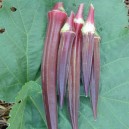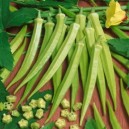
Welcome, Log in
Product Categories
-
Heirloom & OP Seed
- Cool Weather Crops
- Warm Weather Crops
- Beans
- Beetroot
- Brassicas
- Carrots
- Chard
- Corn/Maize
- Cucumbers
- Eggplant (Aubergine)
- Leeks
- Lettuce
- Melons
- Okra
- Onions
- Parsnips
- Peas
- Peppers & Chillies
- Radish
- Spinach
- Squash & Pumpkins
- Tomatoes
- Turnips
- Unusual / Exotic
- Herbs & Spices
- Fruits & Berries
- Value Packs
- View All Seed
- Gift Vouchers
OkraThere are 2 products.
Please scroll down or click here to view the product list
GROWING INSTRUCTIONS FOR OKRA
Binomial Name: Abelmoschus esculentus
Varieties: Star of David, Hill Country Heirloom Red, Burgundy, Clemson Spineless
Start: Seed or seedling
Germination: 7 - 15 days, 21°C to 32°C
Seed Life (viability): 1 -2 years
Soil: Well drained
Sunlight: Full sun
Sow Seeds: 1cm deep and 8 - 10cm apart
Transplant/Thin to: 30cm apart
Ave. Days to Harvest: 60 - 85
Good Companions: Lettuce, peppers, eggplant, basil, cucumber, melons, cowpeas
Bad Companions: -
Okra, or "Gumbo" as it is also known, has its roots in Northeast Africa. Cultivation spread into the eastern Mediterranean regions. It has been used for thousands of years. A member of the mallow family, it is closely related to flowering hibiscus. One of the earliest accounts of okra is by a Spanish Moor who visited Egypt in 1216. It was introduced to Brazil in the mid-1600s and it is likely that the French colonists of Louisiana introduced it to America.
Particularly popular in the Southern United States it can be served breaded and fried or as a component of a recipe such as soups, stews or relishes. Okra is a typical ingredient of Cajun and Creole dishes. Because it is considered too gooey it is rarely served alone. Four to six plants are usually enough for most families; way too many for others.
Sowing & Planting: Okra likes fertile, well-composted soil and needs moisture and warmth to thrive. Soak seeds for overnight before directly sowing into warm soil or start indoors three to four weeks prior to your last expected frost. You must be careful not to damage the roots during transplanting.
Although okra typically has no problems with disease or pests it is very sensitive to frost. Heat-loving okra is capable of withstanding dry periods once estabished. Okra can grow to around 75cm wide and 120-180cm tall.
Growing: The key to maintaining okra production continuously throughout the summer is to harvest regularly. Only 3 to 4 days are required from the time the okra flower opens until the pod reaches harvest maturity. For this reason, okra must be harvested at least every other day during the growing season. Failure to remove mature pods from the okra plant will cause reduced yield and quality of pods which set on the plant later.
The pods are either cut or broken from the plant and should be refrigerated or used as soon as possible after harvest.
Harvesting: Harvest the pods young before they are too large, usually between 5 and 10cm long. After that they become fibrous. Harvest often to increase production. Okra should be used as soon as it is harvested. Special care should be taken when harvesting okra because it can irritate the skin of some gardeners.
-
R 25.00Out of Stock More Details
Coming Soon -
R 25.00Out of Stock More Details
Coming Soon







